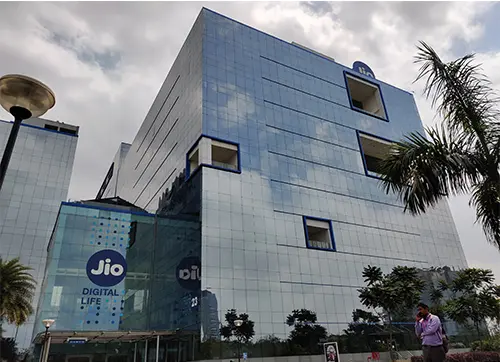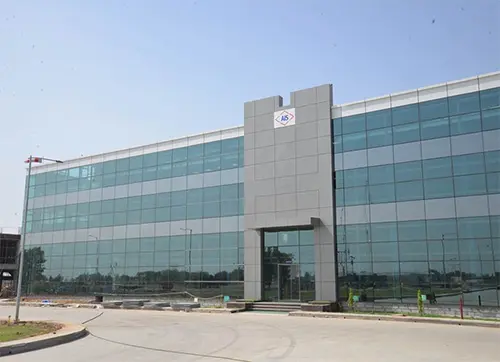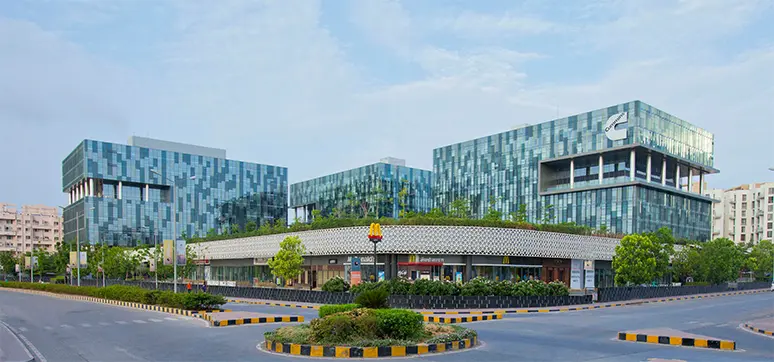What is the size of the present architectural glass market in India?
The Indian glass market is evaluated at around INR 125 billion in FY 22 and is projected to expand at a CAGR of 6-6.5% through FY 2028. Growth in the Indian glass market is majorly driven by the growth of value-added products which cover high-performance glasses and other specialized glasses which help in achieving sustainability through their functional properties. The growth of coated glass in India is largely led by the domestic players because of the obvious advantage of supply through local players to save on fuel and carbon emissions.
While the major driving factor for the glass industry is high-performance glass, the concern is that this consists of a very small share of the overall glass market. Coated glass is only 13-15% of the total glass market which in other developed countries is around 40-45%. The major share of the façade industry is still using non-performance glasses like clear and tinted glass which makes a building highly energy inefficient. In the glass value chain, apart from glass manufacturers, processors also play an important role. The availability of the processors in the market ensures the use of safety and security glasses. Currently, we have around 400 processors, but very few of them are certified by BIS which is an issue of concern. The Indian flat glass market in the value-added glass segment is projected to register a CAGR of over 8.5% during the forecast period.
What are the driving factors of the architectural glass industry?
Some of the driving factors of the architectural glass industry are:
-

AIS project in Navi Mumbai for Jio using high performance AIS Ecosense range The growth of the construction and infrastructure sector in India has picked up the pace and is growing at the rate of 7 to 7.5% CAGR up to 2028. This has led to an increase in the demand for glass
- More stringent building by-laws and green building norms along with government support via subsidies as discounts & in Floor Area Ratio (FAR) for green and sustainable projects has led to further adoption of glass
- The understanding of how glass is a versatile material with easy and early installation can save cost and time is helping the industry to opt for higher glass consumption
- The Industry understands good payback periods with energy savings through glass as recurring savings till the lifetime of the building
- Industries are realising the need for the well-being of occupants for better productivity in commercial buildings via natural daylight provided by glass and the energy savings that come along with it
- In the evolution of design trends in modern architecture, glass helps architects create visually appealing structures with enhanced aesthetics, allowing natural light, and creating open, spacious environments.
- Glass being a sustainable material, it is now being sought as the best material to make buildings more liveable
- With the advent of advanced technologies in the glass industry, coated glass has become more advanced and at the same time more affordable.
- Over the short term, increasing demand from the construction industry and growing demand for electronic displays are major factors driving the growth of the market studied.
- However, the increasing cost of raw materials is a key factor anticipated to restrain the growth of the target industry over the forecast period.
- 100% foreign direct investment in the construction industry in India under automatic route is permitted in completed projects for operations and management of townships, malls/shopping complexes, and business constructions.
- By 2025, the Indian construction market output is expected to grow, on average, by 7.1% each year. The real estate industry in India is expected to reach USD 1 trillion by 2030.
- ICRA estimates that Indian firms are expected to raise INR 3.5 trillion (USD 48 billion) through infrastructure and real estate investment trusts in 2022, compared with raised funds worth USD 29 billion.
- According to the IBEF, In the first half of 2022, office absorption in the top seven cities stood at 27.20 million sq. ft. between July 2021-September 2021, and a total of 55,907 new housing units were sold in the eight micro markets in India (59% YoY growth).
- As per the IBEF, the market size of Indian real estate for the forecast year 2030 (F) is valued at USD 1,000 billion.
What are the evolutions in Architectural / Performance Glass technologies? How do you envision the glass façades of 2050?

Predicting specific changes in façade and fenestration design by 2050 is speculative. Still, there are several trends and potential developments in architecture and construction that may influence these aspects of building design in the coming decades:
- Sustainable & Energy-Efficient Design: Advanced materials & technologies, such as smart windows, energy-efficient glass, dynamic shading systems, and improved insulation, may become standard features to reduce energy consumption and greenhouse gas emissions.
- Integration of Renewable Energy: Building-integrated Photovoltaics (BIPV) could be seamlessly integrated into the façade’s design.
- Smart Façades: Façades might become more intelligent, using sensors and automation to respond to environmental conditions. Smart fenestration systems could adjust in real time to optimize natural lighting, ventilation, and temperature control.
- Adaptive Design: Adaptive façades could adjust their appearance and performance based on external factors. This might include changing colours, patterns, or transparency levels to respond to weather conditions, lighting, or user preferences.
- Biophilic Design: Façades may incorporate more biophilic design elements to connect occupants with nature. Green walls, vertical gardens, and façades designed to support biodiversity could become more common.
- Advanced Materials and Technologies: The development of new materials, such as transparent wood, graphene, and self-healing materials, could lead to innovative façade designs. Other than that technologies like 3D printing can design customised façades.
At AIS, we are actively engaged in conducting various research and studies aimed at influencing market practices in specifying the most suitable products based on thorough building and climate analyses. One of our ongoing initiatives involves a comprehensive climate study, focusing specifically on the tropical climate in India and the corresponding performance values of glass.
This climate study is designed to provide valuable insights for specifiers, helping them comprehend the significance of performance values and how to effectively optimise them based on distinct climatic zones. Additionally, the study considers various Window-to-Wall Ratios (WWRs) across different building typologies. The goal is to empower specifiers with the knowledge and tools necessary to make informed decisions about glass selection, ensuring optimal performance in diverse environmental conditions.
By delving into the nuances of the Indian tropical climate and correlating these findings with the performance metrics of glass, we can contribute to a more informed and efficient approach to building design. Our research endeavours ultimately seek to enhance the overall understanding of how glass performs in specific climates and under varying architectural parameters, facilitating the creation of sustainable and energy-efficient structures tailored to the unique demands of different regions and building types.
What is your forecast for the industry for the next seven years, that is for 2030?
There is a scenario shift in the industry, where people are getting more aware of green buildings and the importance of sustainable materials in building construction.
- New amends are being brought up by building codes, and green building organizations to spread the concept of sustainability to local tier 2 and 3 cities.
- Now this shift is positive as it will ensure adequate glass products to be specified for a major chunk of urban fabric. It will also be an initiative for this industry to become more organised.
- The Indian glass industry’s growth has been driven primarily by the construction sector. The construction and infrastructure industry holds the highest market share in the Indian flat glass market due to the growing demand for flat glass in residential building projects.
- Annealed glass is used in the windows of buildings. In India, several green buildings or LEED buildings focus on reducing carbon footprint in various ways. One of which is using performance glass to access natural daylight.
- According to Green Building Information Gateway, the residential complex DLF Camellias in Gurugram is India’s largest LEED-certified green building with a size of 4.7 million square feet as of April 2021.
- According to the Department for Promotion of Industry and Internal Trade (India), the proposed investment value in the glass sector in India for the fiscal year 2021 amounted to INR 57.12 billion (~USD 0.77 billion) as compared to the fiscal year 2020 with the proposed amount of INR 5.67 billion (~USD 0.08 billion).














